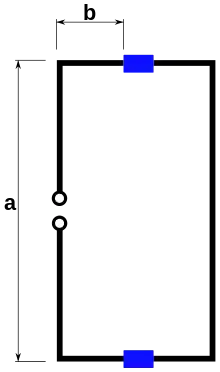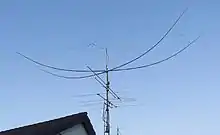Moxon antenna
The Moxon antenna or 'Moxon Rectangle' is a simple and mechanically robust two-element parasitic array antenna. It takes its name from the amateur radio operator Les Moxon (amateur radio call sign G6XN).[1]


.jpg.webp)
Design
The design is rectangular, with roughly half the rectangle being the driven element and the other half being the reflector. It is electrically equivalent to a two element Yagi antenna with bent elements and without directors. Because of the folded ends, the element lengths are approximately 70% of the equivalent dipole length. The two element design gives modest directivity (about 2.0 dB) with a null towards the rear of the antenna, yielding high realized front to back ratio. At 28 MHz antenna gain up to 9.7 dBi can be obtained.[2]
Practical Construction
The Moxon antenna is popular with amateur radio enthusiasts for its simplicity of construction. The drawing shows the system of construction. The driven element is at the left, and the parasitic on the right, mechanically connected with an insulator (blue in the drawing). The antenna is in layout similar to the well known VK2ABQ-Square. For use on shortwave-bands spreaders are commonly made of bamboo or glass-fiber reinforced plastics, carrying a radiator and reflector made from wire. Such antennas can be built with little wind load and minimal weight. AC6LA provides a calculator which is developed from former algorithms of L.B. Cebik, W4RNL.[3] W4NRL has made detailed comparisons and calculations on several different antennas.[4] Moxon antennas are often used by radio amateurs in portable forms and on field days because of their lightweight construction.
Literature
- Les A. Moxon (1993). HF Antennas for All Locations (2 ed.). Radio Society of Great Britain. ISBN 1-872309-15-1.
- Allen Baker (April 2004). "A 6 Meter Moxon antenna". QST Magazine. American Radio Relay League.
References
- "KD6WD's Moxon Antenna Project". Archived from the original on 2018-11-24. Retrieved 2019-06-12.
- "Moxon Antenna Modeling – The 4NEC2 Optimizer Function" (PDF) (PDF). Archived from the original (PDF) on 2017-02-28. Retrieved 2019-06-12.
- AC6LA. "Moxon Calculator for Microsoft Windows: Moxon Rectangle Generator". Retrieved 2019-06-12.
- W4RNL. "The Moxon Rectangle: A Review". Retrieved 2019-04-18.
External links
- N3WWN. "Moxon Calculator for the web browser". Archived from the original on 2015-08-02. Retrieved 2019-06-12.
- "KD6WD's Moxon Antenna Project". Archived from the original on 2018-11-24. Retrieved 2019-06-12.